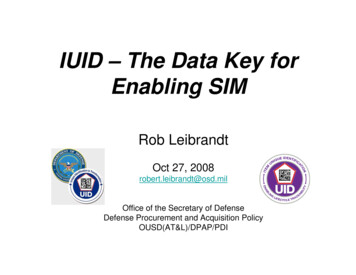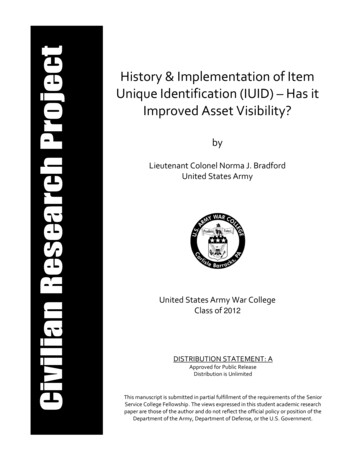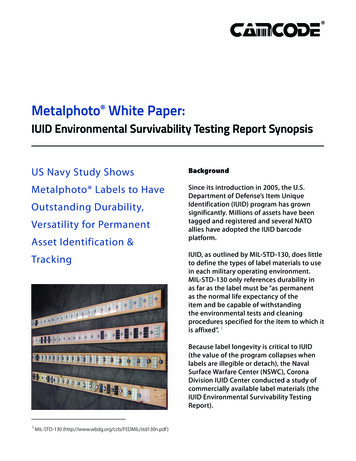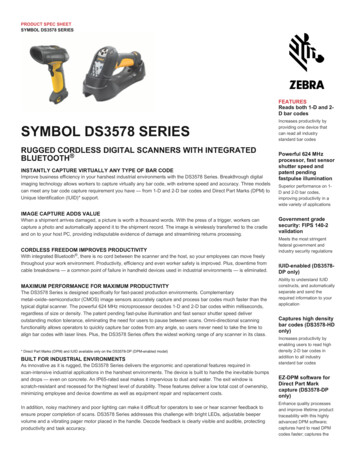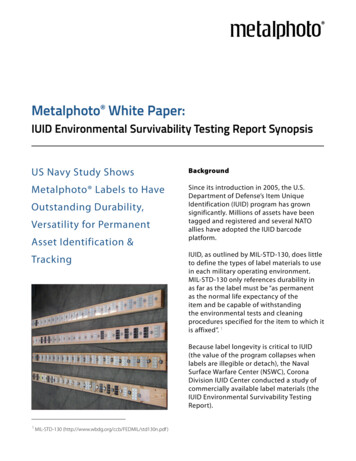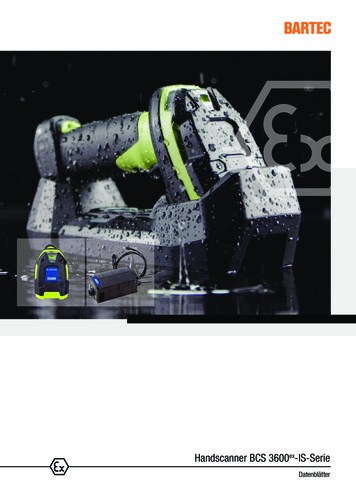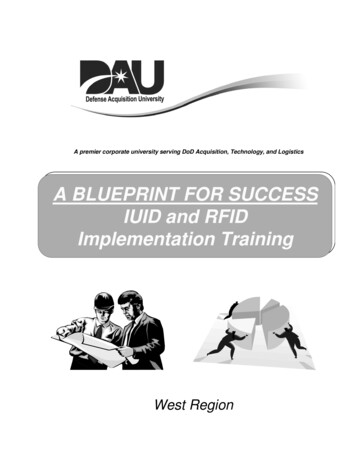
Transcription
A premier corporate university serving DoD Acquisition, Technology, and LogisticsA BLUEPRINT FOR SUCCESSIUID and RFIDImplementation TrainingWest Region
IUID and RFID Implementation TrainingItem Unique Item Identification (IUID) vsRadio Frequency Identification (RFID)Dr Tom Edison, DBA,CPLProfessor of Life Cycle LogisticsDefense Acquisition UniversityWest RegionSan Diego, CA619-524-4815tom.edison@dau.mil1First Some Stuff on Supply Chain What it isSCOR ModelHow IUID and RFID Fit21
IUID and RFID Implementation TrainingSupply Chain Management: The Basics&Item Unique Item Identification(IUID) &Radio Frequency Indentifciation(RFID)3Supply Chain Management:What is it?How can I use it?Where can I learn more about it?42
IUID and RFID Implementation TrainingI don’t know what the hell logistics (orSupply Chain Management) is But I want some of it!CINC US Fleet, Chief of Naval Operations,Advisor to President Roosevelt - Admiral E. J. King5Traditional Support ElementsMaintenancePlanningManpower &Supply SupportPersonnelSupportEquipmentTraining &SupportTechnical DataComputerResourcesSupportFacilitiesPackaging, HandlingStorage, &TransportationDESIGNINTERFACESYSTEM36
IUID and RFID Implementation TrainingWhat Weapon System Is It?12/26/2006Overview of Intermediate AcquisitionLogistics7F-16 Weapon System Includes 12/26/2006Overview of Intermediate AcquisitionLogistics48
IUID and RFID Implementation TrainingIPT Teamwork9Logistics TransformationObjectives Project and sustain the force with minimalfootprintImplement performance-based logistics tocompress the supply chains and improvereadiness for major weapon systemsReduce cycle times to industry standards105
IUID and RFID Implementation TrainingSupply Chains – What are they? Supply Chain – Refers to the flow of materials,information, funds, and services from rawmaterial suppliers through factories andwarehouses and retail outlets to the end customersA Supply Chain also includes – the organizationsand processes that manufacture and deliver thoseproducts, information, and services to the endcustomers11SUPPLY CHAINMANAGEMENTProcess of planning, implementing and controlling theefficient, cost effective flow and storage of raw materials,inventory, finished goods, and related informationfrom point of origin to point of consumption.ICPVENDORSDEPOT6WARFIGHTERS12
IUID and RFID Implementation TrainingThe Essence of Supply ChainManagement The seamless integration and management of : Materiel movementInformation flowsFinancial transactionsAcross all nodes of the supply chain and with all supplychain partnersIt differs from traditional logistics management: Focus on processes (plan, source, make /repair, deliver,return) instead of function (e.g. supply, maintenance,transportation and procurement) Focus on all organizations in the supply chain (cutsacross all partners) instead of just your organization13Supply Chain ManagementThe management of all internal and external processesor functions necessary to satisfy a customer’s orderfrom raw material through conversion/manufacturingthrough shipment.147
IUID and RFID Implementation TrainingSupply Chain ManagementThe management of internal logistics functions andthe relationships between your enterprise and itscustomers and suppliers15Supply Chain OperationsReference (SCOR) Model The SCOR Model captures and documents theSTEPS, FUNCTIONS, PROCESSES, BESTPRACTICES, and METRICS of SCMWithin each Function/Process, it offers bestpractices and strategies that may be used toimprove the DoD supply chainThose best practices and strategies are shown inthe following charts, and are useful inunderstanding the critical issues and challenges ofeffective SCM.168
IUID and RFID Implementation TrainingCommercial Supply TERCUSTOMERRETAILER17DoD Supply ChainPRIMEVENDORSSERVICEICPsRETAIL SUPPLYServiceables“I” LEVEL MXSERVICESUBCONTRACTORS MAINTENANCEDEPOTSReparablesUNIT A SUPPLYCENTERSDLA DISTRIBUTIONCENTERS918
IUID and RFID Implementation TrainingSupply Chain OperationsReference (SCOR) Model Commercial model adopted by DoDMaintained by Supply Chain CouncilHorizontal view (Supply Chain Partners): from customers’customers to suppliers’ suppliers19DoD SCOR ModelDoD equivalent processes at bottomPrime ContractorSub-Contractoror OEMMaintenance ActivitiesMaintenance DepotsInventory Control PointsRetail Supply & MaintenanceDistribution/TransportationUnit Level Supply & Maintenance10Warfighter20
IUID and RFID Implementation TrainingThe SCOR Model Equates to DoD Processes and FunctionsEffective SCM requires integration of Material,Information, and Financial TransactionsSupplier’s SupplierSubcontractorSupplier DoD Make/Repair CustomerSupplier orDistributorDepotRetail Supply/Maintenance “I” or “O” Service FlowFlows in Both DirectionsInformation FlowFinancial Transaction Flow21SCOR Tools Applicable to DoD Best Practices Drawn largely from private sector, but includeinnovative DoD initiatives Strategies Detail various approaches to structuring andmanaging the supply chain to increaseefficiency2211
IUID and RFID Implementation TrainingBest PracticesSCOR “PLAN” – DoD “Forecast” Demand-based forecasting versusRequirements forecasting Capture demand at point of use Vendor Managed Inventory Let Vendor worry about forecasting andmaintaining adequate inventory levels andbearing the cost of same Forecasting software (APS, CPFR)23Best PracticesSCOR “Source” – DoD “Procure” Strategic sourcing: segmenting itemsPrime Vendor – consolidate “buy” responsibilityE-Commerce toolsPerformance-based ContractingCollaborative (special) supplier relationshipsPBL: Outsource wholesale item mgmt2412
IUID and RFID Implementation TrainingBest PracticesSCOR “Make” – DoD “Repair” Demand-based Repair: PULL based vs. PUSH basedRepair cycle time reduction (reengineer, remove steps,implement new technology)Segment critical vs. non-critical items; don’t treat all itemsthe sameInformation integration Repair right items, not wrong items Advance warning of long lead-time parts deficiencies Allows pro-active actions to mitigate25Best PracticesSCOR “Deliver” – DoD “Distribution” Customize Delivery: Direct Vendor Delivery Premium Transportation In-Transit Asset Visibility (ITAV) Track, trace, dynamic rerouting Implement Metrics Customer Wait Time Logistics Response Time2613
IUID and RFID Implementation TrainingBest PracticesSCOR “Return” – DoD “Retrograde” In-transit visibility (ITAV) Track, trace Disincentivize ‘hoarding’ of carcasses (forcannibalization) Reduced credits for “stripped” carcasses Zero credit for extended non-return Improve return transportation cycle time27The Warfighter Perspective“Someday I want Federal Express to ask ushow we do business.”Lt. General Richard KellyDeputy Commandant, Installations andLogistics, USMC2814
IUID and RFID Implementation TrainingSupply Chain Best PracticesCondensed SummaryDemand based forecasting vs. requirements ForecastingVendor managed inventory Forecasting software PLAN Strategic sourcing – segmenting itemsPrime Vendor; e-commerce tools Performance-based contracting; collaborative relationships SOURCEMAKE/REPAIR Demand-based repair (PULL based vs. PUSH based)Repair Cycle Time reduction Segment critical vs. non-critical items Information integration Customized delivery: Direct Vendor Delivery, Premium Trans.In-transit visibility (ITAV) Implement tracking metrics (CWT, LRT) DELIVER In-transit visibility (ITAV)Disincentivize hoarding of reparable carcasses for rob-back Improve return transportation cycle time RETURN 29Supply Chain Management DoD’s supply chain is characterized by inefficiencies– multiple handoffs, lack of end-to-end visibility, etc.SCM, and the SCOR Model, provide many bestpractices and processes that can be of value in DoDSCMPBL facilitates SCM best practices by optimizing forthe customer – the weapon system, vice internal DoDsupply processes3015
IUID and RFID Implementation TrainingOne Caution - Organizational CultureNewConcept Old DysfunctionalOrganizationOld OrganizationTLCSM/PBL/SCM Sub-Optimized NoTransformation!IUID OverviewGenesisArchitecture/Life Cycle/Business RulesWide Area WorkflowImplementation PlanReference SourcesRFID HistorySystem DesignSpecturmBenefits/Applications3216
IUID and RFID Implementation Training“I think the industry has solditself on a program that offersso little return that it simplywon’t be worth the trouble andexpense”A Midwest Grocery ChainExecutive discussing thepotential of the barcode in 197533Déjà vu All Over Again ?.Marsh’sSupermarketTroy, OhioJune 26, 197467 Bar Codes Transformed Retail Sales and Inventory Management1734
IUID and RFID Implementation TrainingFacing newchallenges Rapidly moving force on adynamic battlefieldDemand for betterinformation on assetsNeed for more effectivevisibility and managementof inventoryImprove business processes nowImprove confidenceInfluence the direction and cost oftechnology developmentDrive the standards to work for usFacilitate the implementation ofUnique Identification (UID)35THE NEW TERMINOLOGY UID – Unique Identification IUID – Item Unique Identification UII – Unique Identification Item RFID – Radio Frequency Identification CMB – Contact Memory Button1836
IUID and RFID Implementation TrainingAutomated Identification Technology SuiteSmart Card/CACLinear Bar Code2D SymbolCMBContact Memory ButtonOMCOptical Memory CardRFID - ActiveRadio Frequency IDSTSSatellite-Tracking SystemsRFID- PassiveRadio Frequency ID37Automated Information Technology (AIT)DoDD 5000.2Para 3.9.2.4.1: PMs shall optimizeoperational readiness through affordable,integrated, embedded diagnostics andprognostics, and embedded training andtesting; serialized item management;automatic identification technology (AIT);and iterative technology refreshment.3819
IUID and RFID Implementation TrainingThe Genesis of UII GAO concerned with DOD management of its inventoryof equipment. Finding: DOD’s inventory exceeded its war reserve orcurrent operating requirements, but lacked key spareparts (particularly aviation spares) due to a lack ofadequate accountability over material shipments oreffective monitoring of defective spare parts.GAO-02-477G (Mar 02): Executive Guide, Best Practices in Achieving Consistent, Accurate PhysicalCounts of Inventory and Related Property39UID Program-Integrated Situational Awareness of People, Places and ThingsToday -- No UIIsNo integrated planning viewTo Be State -- UIIsIntegrated planning viewRequirement: Capability to integrateforce structure planning for identifyingand constituting deployable combinedforce modules. Who is available? With what equipment? Where are they now? How long can we supportthem?People, things andproperty related toforce structure.Deployment and constitutionoptions can be continuouslyevaluated.Site UID Creation Site UID CreationRequired items identified,pre-positioned andtracked with RFID.RFID TrackingPeople and things can beidentified to sites andfacilities for rapiddeployment response.QuestionsQuestions answered2040
IUID and RFID Implementation TrainingDoD Vision forItem Unique Identification (IUID)To implement a policy establishing a strategicimperative for uniquely identifying tangible itemsrelying to the maximum extent practical oninternational standards and commercial itemmarkings and while not imposing uniquegovernment data requirements.Uniquely identified (UID) tangible items willfacilitate item tracking in DoD business systemsand provide reliable and accurate data formanagement, financial, accountability and assetmanagement purposes.Effective 1 January 04 Mandatory for Solicitations41UID“Unique identification is the ability to physicallydistinguish one item from another We view a uniqueidentifier as a set of data for assets that: is globally unique and unambiguous ensures data integrity and data qualitythroughout life supports multi-faceted business applicationsand users”4221
IUID and RFID Implementation TrainingUID: What makes it so Special?UID ¾ Provides “The Key” to discovery and correlation of item, realproperty and human resource information so – DoD can consistently locate, control and value assetsanywhere and anytime¾ Enables globally accessible and secure enterprise data¾ Registries enable creation of UID mission critical services to Translate legacy data for existing DoD systems Enable access for operational support Enable joint paperless management43UII: What Is It?In today’s world, many items we buy have identification on them that indicate themanufacturer or distributor of the product and the product type.Two identical cans of Coke from the same bottling plant will showthe same data on the Universal Product Code (UPC)Some items also have a serial number that differentiates one item from another identicalitem (e.g., the 24th engine off the assembly line is different from the 1024th)Serial numbers are unique, but not outside of their enterprise – theserial number assigned by XYZ Manufacturer could be the same asone assigned by ABC Company.By combining enterprise identification, item class and serialization, a globally unique itemidentifier is created that differentiates each item from other itemsEach item has its own globally unique identifier (UID)4422
IUID and RFID Implementation TrainingUnique Item Identifier (UII) is .UII is . . . . . the set of data for tangible assetsthat is globally unique andunambiguous, ensures dataintegrity and data qualitythroughout life, and supports multifaceted business applications andusers.EID(12V)194532636Orig. Part No.(1P)1234Serial No.(S)78695045UII462923
IUID and RFID Implementation TrainingWhat you see: Can contain 100 times the data as the same space in a barcode Can be read omni-directionally Can be damaged but still return accurate data Can be scaled up or down to fit within available marking spaceWhat the Reader sees:[) RSDDGSMFR 0CVA5 GSSER 786950 RS EoT47The Main Direct Part Marking ProcessesDot PeenElectroChemiEtchInk JetLaserSource: Rolls-Royce, Nat Russhard4824
IUID and RFID Implementation TrainingSource of UII Qualifying CriteriaDepartment of Defense (DoD) Instruction 5000.64,Defense Property Accountability, requires thataccountability records be established for allproperty (property, plant and equipment) with aunit acquisition cost of 5,000 or more, and itemsthat are sensitive or classified, or items furnishedto third parties, regardless of acquisition cost.49Defining the Scope of an UIIA UII Is9999999A Data ElementA Unique Identifier foran ItemGlobally UniqueUnambiguousPermanentCreated byConcatenating SpecificData ElementsThe enabler for businessintelligenceA UII Is Not9999A Device forCommunicating Data, suchas Radio FrequencyIdentification (RFID) Tags,Contact Memory Buttons,Linear Bar Codes, or 2-DData MatricesA Replacement for theNational Stock NumberIntelligent Data that YieldsInformation About the ItemTransferable from one itemto another2550
IUID and RFID Implementation TrainingUID Policy Overview Policy memorandum released on July 29th 2003 established IUID as amandatory DoD requirement on all solicitations issued on or after January1, 2004.IUID is required for all property items delivered to the Government if: Acquisition cost is more than 5,000 Items with an acquisition cost below 5,000, when identified by therequiring activity as DoD serially managed, mission essential, orcontrolled inventory Items with an acquisition cost below 5,000 as determined by therequiring activity Regardless of value, any DoD serially managed subassembly,component or part embedded within an item and the “parent”item in which it is embeddedWide Area Workflow (WAWF) is the preferred method for capturingIUID data and will be a mandatory payment requirement no later thanJanuary 1, 200551Key Direction from UID Policy Updates¾Apply IUID to legacy items in inventory and operational use¾All program and item mangers plan for and implement IUID- ACAT 1D programs submit plans by June 2005- All others to MDAs by January 2006¾Plans should target FY2007 as the point by which:- All existing serialized assets will be entered in UID registry- UII marking capabilities established such that marking cancommence when equipment is returned for maintenance¾Government Furnished Property (GFP) must meet UIDpolicy requirement effective 1 Jan 20065226
IUID and RFID Implementation TrainingKey Direction from UID Policy Updates(Continued)¾ DUSD (Logistics and Material Readiness) develop UIDimplementation plan for organic depot maintenanceoperations¾ DCMA negotiate corporate/facility strategies with top30 DoD suppliers¾ DCMA issue UII quality assurance plan¾ AT&L work with Services/Agencies to modernizeinfrastructure, reengineer business processes, reviseAutomated Information Systems (AIS)53Evolutionary Approach toLegacy IUID5427
IUID and RFID Implementation TrainingUSD (AT&L) Memorandum 12 May 2005 Guidance for review of IUID implementation at milestone reviewsEstablishes requirements for applying IUID to DoD property in the possessionof contractors (PIPC); Property should only be accountable in one property accountabilitysystem at a time Acquisition value will be recorded and updated in the IUID Registry Eliminate DD form 1662 DoD Property in the Custody ofContractors IUID Registry will Not be a property accountability system but provide audit trail ofproperty in current and previous accountability systems. Maintain master IUID data Be updated with key transaction events but not maintain detailedtransactional data Develop interfaces between IUID Registry and component specific propertysystems Add IUID to logistics policies and integration with serialized item tracking. Clarifications in Attachments55What is the UII Life Cycle?Dispose – DoD/GSArecords the“termination” of theUII at time of itemdisposalUse – Functionalstakeholders use UII asa primary or alternatekey in the AIS to accessor update iteminformation based onits UIIRequire – DoD contracts reflect therequirement for part marks toinclude UII data elements for allitems which require uniqueidentificationCreate/Generate – Industrysuppliers/manufacturersthroughout supply chainassign and apply UII dataelements and ensure theuniqueness of the componentdata elementsUIICapture – DoD establishes the “birth” record of theUII by capturing the machine/human readablecomponent data elements to create the UII in the AIT/AIS2856
IUID and RFID Implementation TrainingItems Requiring UIIs or Equivalents Acquisition cost is 5,000 or more DoD serially managed, mission essential orcontrolled inventory piece of equipment or areparable item, or a consumable item ormaterial where permanent identification isrequired57Solicitation Prep/Contract Award The UII requirement for part marking flows down tosuppliers Assigning final valuation usually occurs at the level of theprime contract. If UII is required on a new contract, major modification, orreprocurement of equipment (such as spare parts), the RFPmust include: The DFARS clause 252.211-7003, Item Identification andValuation MIL-STD-130M DID for imbedded UIDs (optional)5829
IUID and RFID Implementation TrainingData Item DescriptionInformation needed toprepare a DD Form 1423Contract DataRequirements List(CDRL)for embedded UIIs bytailoring the data itemdescription forBar Code IdentificationReport (DI-MGMT80177A)59Create and Generate the UIIThe components that make up the UII are identified in the table below.Each enterprise has two options for creating the UII.6030
IUID and RFID Implementation TrainingCreate/Generate a UIIUIIUIIUIIThe enterprise that puts the mark on an item is responsible for guaranteeing that theserial number assigned to the item is unique to that item.61Placement of the UIIData elements for unique identification willbe placed on qualifying items in accordancewith the standard practice of MIL-STD-130,Identification Marking of U.S. MilitaryProperty. (Note: current version is “M”)Once delivered, the UII and valuation remain the same for the life ofthe end-item. UIIs cannot be reused, even if the item is destroyed6231
IUID and RFID Implementation TrainingApplying the UII Vendor-Applied-at-Source: Marking applied when item is manufactured Opportunity-Based Item Application: Can be done in the field or factory,wherever it is convenient to gain access to items either on an end item oravailable in a storage facility (phase maintenance, scheduled servicing, depotrebuild or overhaul processes, and work-order processes during modification) Seek-and-Apply: Used for particular items held within service, either at theend item or in storage. This strategy is dependent on establishing the locationand availability of items before deployment of application equipment andteams. This approach is dependent upon good legacy data, and will demandgreater overhead of coordinated effort to effect access to the assets. Gated: The interception of items as they transit specific gates within thesupply chain. After identification, the situation can be resolved by divertingthe item back to the vendor for application, provision of an applicationcapability at the specific supply gate, or diversion of the item to a centralizedapplication facility.63Use of Commercial Identifiers Commercial identifier can be considered for use as a DoD UIDequivalent if it meets these criteria: Must contain an enterprise identifier Must uniquely identify an individual item within an enterpriseidentifier, product or part number Must have an existing Data Identifier (DI) or Application Identifier(AI) listed in ANSI MH10.8.2, Data Identifier and ApplicationIdentifier Standard Some examples of commercial unique identifiers meeting these criteriaare: Global Individual Asset Identifier (GIAI) for serially-managedassets Global Returnable Asset Identifier (GRAI) for returnable assets ISO Vehicle Identification Number (VIN) for vehicles Electronic Serial Number (ESN) for cellular telephones only.6432
IUID and RFID Implementation TrainingUIIUIIUII6523Capture: IUID RegistryWide Area Workflow (WAWF) IUID Registry is the central repository for IUIDinformation and serves as an acquisition gateway toidentify: What the item is How and when it was acquired The initial value of the item Current custody (government or contractor) How it is markedSupports full lifecycle visibility for tangible items,integrating financial, maintenance, and accountabilitysystems.Maintained by the Defense Logistics Information Service(DLIS), Battle Creek.6633
IUID and RFID Implementation TrainingCapture: What Data is Included in IUID Registry Pedigree Acquisition ContractInformation Original Part Number Shipment and DeliveryInformationValuation Initial Acquisition Value Changes in Valuation Accountability Contractor CustodyInformation Acceptance Data Contract DataConfiguration Embedded Items Item Markings Part Number Changes Registry is located on the internet at https://www.bpn.gov/iuid. Users must register to obtain login credentials and access rights to controlled access portion Must be a government employee or a U.S. Government Contractor with approval from aDoD Program Manager or equivalent. Prior to registering in IUID Registry, commercial manufacturers and governmentmanufacturing activities must be registered with the Central Contractor Registration(CCR) system at https://www.bpn.gov/ccr/scripts/index.html67Other UII Business Rules addressed inUII Guide What to do when: items are missing the data elements required toconstruct the UII legacy items that cannot be uniquely identified usingUII Construct #1 or #2 or a UID equivalent Original part number cannot be precisely determined Items considered tangible personal property owned bythe Government are in the possession of a contractor6834
IUID and RFID Implementation TrainingUII Marking by DoD There will be non-recurring costs to make the appropriatechanges to drawings and marking instructions for legacyspare parts, in accordance with MIL-STD-130Mrequirements. It may be desirable for the DOD-requiring activity to markitems when received rather than require the vendor tomark until the vendor’s internal capabilities areestablished. The requiring activity must ensure that DODactivities can guarantee that the UII information they useis unambiguous and globally unique through life.69The Virtual Unique Item Identifier (UII) Enables the data base entry of a UII and its associatedpedigree data, while postponing the physical marking ofthe item with a two-dimensional data matrix symbol to amore advantageous time based on logistic and economicconsiderations. Used for DoD-owned legacy personal property items,which are: Items and embedded items that have already been produced anddeployed for use, or placed in inventory or storage pending issuefor use, and DoD resident equipment and spares in the possession ofcontractors.7035
IUID and RFID Implementation TrainingUID (UII) Implementation Plan *¾ Provide references including service UII CONOPs, Instructions, Relevant ServiceUII Policy documents (Most recent draft for those documents in development) andprime contractor(s) Single Process Initiatives if available¾ Describe the overall UII Implementation Strategy to includeMarkingCurrent and future contractsLegacy itemsDepot Manufactured items and plant equipment¾ Technical documentation strategy to minimize the non-recurring costs formarking,¾ Describe the business strategy for implementing UII¾ Identify UII related opportunities to improve or enhance business processes.¾ List MetricsExit CriteriaMeasures of Success* Template on UID Home Page71Key Responsibilities for IUIDImplementation Program Managers will identify items embedded in end items that requireunique identification, including embedded subassemblies, components andparts. These embedded items will identified in a Contract Data RequirementsList (CDRL) or Exhibit. Contracting Officers shall include the clause at 252.211-7003, ItemIdentification and Valuation, in all solicitations and contracts that requiredelivery of items. All items delivered to the Department will be delivered under a contract lineitem and the Department’s acquisition cost of each item will be identifiedunder a contract line item or sub-line item Contractors are required to provide unique item identification, or a DoDrecognized unique identification equivalent, for all items delivered with anacquisition cost of 5,000 or more and as designated by the requiring activityfor items less than 5,000. Under the clause at 252.211-7003, marking of items shall be in accord withMIL-STD-130L, Identification Marking of U.S. Military Property.7236
IUID and RFID Implementation TrainingUnique Item IdentificationReference Sources737437
IUID and RFID Implementation TrainingMay 2006 UID e-newsletter757638
IUID and RFID Implementation Training777839
IUID and RFID Implementation TrainingOther Information Tools DoD Guide to Uniquely Identifying Items: Outlines the UID process,business rules, and UID constructs UID 101: This guide explores all aspects of this initiative and is intendedto provide an understanding of how DoD program offices and commercialbusinesses can successfully implement the Unique Identification (UID)policy Guidelines for the Virtual Unique Item Identifier (UII): This documentdescribes the virtual unique item identifier (UII) concept, the processes forassigning and registering virtual UIIs, and the prospective marking ofitems that have virtual UIIs. Guidelines for Engineering, Manufacturing, and MaintenanceDocumentation Requirements for UID implementation: Providessuggested methods for minimizing the non-recurring engineering costsassociated with incorporating marking requirements for DoD uniqueidentification into engineering drawings, manufacturing instructions, andmaintenance work records.79DoD Guide to Uniquely Identifying Items and otherrelevant UID materials including policy memos can befound athttp://www.acq.osd.mil/dpap/UID/803440
IUID and RFID Implementation TrainingDoes anyonehave a papermanifest forthis?81RFID Historyannounces top 130-150suppliers must use RFIDby Jan. 1 2005Auto-IDestablishedElectronic ArticleSurveillance (EAS) forretail and librariesAnimal taggingRFID born asIFF1940s1960s1970s1980s Toll collection Access control 1st Gulf Wartagging1990sannounces allsuppliers must useRFID by Jan. 1 2005RFID and itemtagging20032010RFID is referred to as the next generation barcode4182
IUID and RFID Implementation TrainingA Functional RFID System Includes Active:RF in the 400MHz, 900MHz, and2.45GHz rangesRange: Generally 300 FeetUsed predominantly in transportationsystems (rail, toll systems, trucking)Characteristics: Tag with internalpower cell mounted to item. Does nottransmit all of the time. Datacapacity varies. Passive:RF in the, LF, HF, UHF 858-960MHz range. Protocols - uses backscatter technologyRange: Typically measured ininches or meters.Used predominantly in retailsystems.Characteristics: Small tag withlicense plate data – limited datacapacities.83Attributes of RFID A form of electronic labeling - read/write capability Interrogated at a distance - hands free & “On-the-Fly” Non-line-of-sight between reader/scanner and tagged item Can contain large quantities of unique digital info Greater placement flexibility on or in an item Virtually low maintenance Extremely low error rate Data cannot easily be copied Can be interfaced with other micro sensors8442
IUID and RFID Implementation TrainingThe RF SpectrumRFID:Toll Roads& ItemManagementRFID:Access ControlAnimal IDRFID:Smart CardsLow Freq. EASRadioToysVLF10 kHzLFHF10 MHz1 MHz3 km300 mCell PhoneTVGarageFM DoorCBMF100 kHz30 kmAMRFID:ItemManag
IUID and RFID Implementation Training 1 1 Item Unique Item Identification (IUID) vs Radio Frequency Identification (RFID) Dr Tom Edison, DBA,CPL Professor of Life Cycle Logistics Defense Acquisition University West Region San Diego, CA 619-524-4815 tom.edison@dau.mil 2 First Some Stuff on Supply Chain What it is SCOR Model How IUID and RFID Fit
